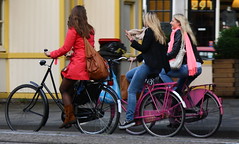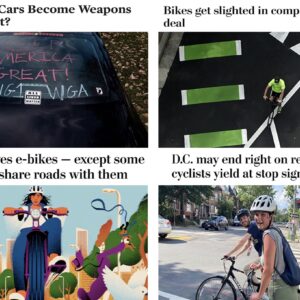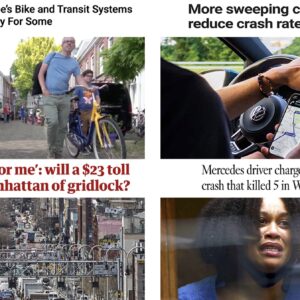
will help increase bicycle use in the US.
(Photo: Will Vanlue/BikePortland)
Here’s the news and other cool stuff that caught our eyes this past week…
– A study from UC Berkeley finds wealthier people tend to act less ethically. After monitoring traffic at an intersection in San Francisco, researchers determined that people with more expensive cars drove more aggressively around pedestrians.
– The Cyclo-Cross National Campionships are coming to Boulder, CO in 2014. City officials and area businesses expect the event to be a big boost to the local economy.
– Wolfpack Hustle is once again hosting its Marathon Crash Race which sends participants along the car-free route of the LA Marathon before it opens to runners.
– The blogger behind a push to double the number of women on bikes in Southern California shares her dream for U.S. bicycle advocacy.
– Researchers at Baylor and Louisiana State Universities found communities with more locally owned businesses have healthier residents than communities housing many large corporations owned by people who live out of the area.
– Medical professionals in the UK are concerned that riding a bike can increase the severity of a warning sign for prostate cancer which may fool doctors and send patients to unnecessary procedures.
– An Australian woman may have her possessions seized and auctioned off by the government to cover a fine for not wearing a helmet while riding a bicycle.
– Officials in Waynesboro, PA are working to refine the design of a new pump track to be built in the Pine Hill Recreation Area.
– Residents of Lynchburg, VA will have to pay to rent bicycles now that a program allowing them to check out bikes for free was suspended.
– Washington DC’s popular bike sharing program is expanding with five new stations slated for installation on the National Mall.
– The Duke and Duchess of Cambridge are vocal supporters of London’s “Boris” bike share system.
– Heisman Trophy winner Bo Jackson will lead a ride through Alabama to commemorate tornado victims.
– MIT students invented the HelmetHub vending machine to dispense helmets at bike share stations.
– For those keeping score, Los Angeles is now home to two new bike corrals.
– Advocates in Illinois are pushing to complete a regional network of trails for pedestrians and people on bikes.
– Bikes are dubbed a “nuisance” on trains in California’s Capitol Corridor.
– A former paralegal in Liverpool launched a bike-based mobile bicycle repair service.
– Indoor bike park Cranx opened over the weekend in Syracuse, New York.
– And finally, an excellent video from fashion label Levi’s to debut their new ‘Commuter’ line of bike-sensitive apparel…
Did you find something interesting that should be in next week’s Monday Roundup? Drop us a line. For more great links from around the web, follow us on Twitter @BikePortland.





Thanks for reading.
BikePortland has served this community with independent community journalism since 2005. We rely on subscriptions from readers like you to survive. Your financial support is vital in keeping this valuable resource alive and well.
Please subscribe today to strengthen and expand our work.
… am I right in my browsing…that the “commuter” Levi’s line only comes in mens sizes?
Not only that, it’s still just their super-skinny 511 cut. I’m a cyclist, I have leg muscle. These don’t fit.
I have 24″ thighs and a 32″ waist. The pair they sent me fit fine.
Didn’t watch the vid. At a Levi’s website, it says the model 511 is made of:
“Performance Stretch Fabric – more stretchable for added mobility and comfort”
http://www.levistrauss.com/news/press-releases/levis-brand-introduces-innovative-mens-commuter-cycling-products
Another interesting detail: “Higher back rise – providing additional coverage when riding”. This is common in cycling tights, but not so common in jeans.
Then again, this may not be a great selling point considering there seems to be a lot of people that don’t have the slightest concern about backside coverage.
I remember when Levi’s were made in the USA.
Yep, super lame.
The main difference in men’s and women’s jeans is price and rear pocket location. I wear women’s jeans all the time because the are less expensive. Just think of them as unisex.
in the past two weeks i have bought two pairs of 550 jeans, one men’s one women’s. the price was the same, but the women’s jeans are made of a somewhat lighter weight fabric.
Just cannot WAIT for Showers Pass to follow suit so that I can spend my $$ more locally on a product I’ve been asking for in stores for a long time.
Also, I think lightweight merino wool accomplishes most if not all of the performance objectives of the Levi’s line, but so far I’ve not found anyone styling merino trousers for the cyclist for casual/work wear.
That is a serious bummer if Levi’s is completely ignoring female cyclists with their commuter line of clothing. I did a quick internet search as well and couldn’t find anything either but hopefully I’m wrong about that.
I’ll be writing a letter to Levi’s later today letting them know women commute by bike too.
I think it’s awesome that Levi’s is coming out with a bike styled line of clothing. Also think it’s perfectly reasonable that a niche product has limited initial scope. If the men’s line is a success, expect to see women’s version.
I’m a woman bike commuter, and already have plenty of bike commuter clothing. It’s called regular clothing.
The Capital Corridor issue can be resolved with a few new cars with slight modifications. The great thing about trains is that it is really easy to add cars, and additional cars only slightly increase fuel consumption. Ridership is up on that line, so I think there would be justification to acquire a few new cars per train, and modify them to store bikes on the lower level, as they do on Caltrain:
http://bicycling.511.org/images/btwd08/239.jpg
the problem with city trains is that the station is only so long… can’t add any trains to MAX because all the stations are limited to 2 trains… so they can only increase the frequency… not sure about the setup of the trains in the article… I know that BART often runs with fewer than maximum cars so adding to those wouldn’t be as tough…
Capital corridor is heavy commuter rail. I suppose I was generalizing too much. Light rail lines are often restricted by platform length. Amtrak services generally are not.
Today’s Yehuda Moon comic is a classic (for those who want to see)… (and he’s even wearing a helmet (the lunatic 😉 ))
http://www.yehudamoon.com/index.php?date=2012-03-05
“noting the makes and models of automobiles — a reliable indicator of socioeconomic status, or SES — and whether their drivers cut off other vehicles or pedestrians. Rude behavior rose with status, and high-SES drivers were roughly twice as inconsiderate as low-SES drivers.”
I suppose we should learn a bit more about the definition of SES, but your shorthand ‘wealthier’ is a bit misleading. People who spend money on ‘expensive’ cars are not necessarily wealthier, but rather they are middle class in their spending priorities.
And these days, when cars are paid for with credit cards, you don’t even have to have the money up front.
I guess what I’m saying is that the study reifies a simplistic relationship between wealth, status, and expensive cars, when I think it is really more complicated.
For instance, I’ve noticed that here in town drivers of late model full size pickup trucks (for instance) are far more likely to pass me aggressively when on a bike than, say, people driving Japanese cars built in the 80’s. The people driving the 80’s Japanese cars may be wealthier than the kids in the late model pickup trucks. Social class and car purchasing patterns, or for that matter wealth and car purchasing patterns, are not simple linear functions.
Out of the 8 times I have ben hit, 6 were Lexus, one an Escalade, and one was a beat up Subaru station wagon. Can you guess which of these cars stopped to see if I was ok and exchange their info with me?
*been hit
You get hit way too much.
that is a lot of times!
I think what the study is finding and what we are observing is probably largely the same thing. Folks who drive in a manner that is unkind to other participants in traffic often drive cars that are expensive display objects as much as they are ‘vehicles.’
My point is just that this codes for many things besides ‘wealth’ or ‘status.’ Status-insecure is I think a better descriptor.
If I had to hypothesize I’d say that of those individuals that:
() purchase high value automobiles AND
() are overly aggressive
it is more likely that the aggressors are those of lower SES that are less secure in their SES, subconsciously of course, and act out their insecurities in violent automotive ways to prove their alleged superiority.
People that are actually rich have nothing to prove.
I believe that people who drive luxury cars are more likely to be rude, but doubt that there is a correlation between rudeness and wealth. I read somewhere (can’t find the source) that over 2/3 of luxury car owners are not millionaires and that less than 1/3 of millionaires drive luxury cars. Most people who drive luxury cares have high incomes, but little wealth. Some are worth less than nothing because they spend faster than they earn.
“Wolfpack Hustle is once again hosting it’s Marathon Crash Race…”
I realized this is a nitpick but “it’s” = “it is”. Sorry. Probably a subtle thing but I begin to lose respect for web sites that use “commonly misused words”.
http://pilinutpress.com/index_files/CommonlyMisusedWords.html
Thanks for catching that! That’s what I get for proofreading before the sun is up. 🙂
Nice! Thanks for updating. 🙂
nearly every other article here has a grammar error… I’m smart enough to make up for it in my brain… but yeah, I wish they were proofread better…
I’m confused which link the photo accompanying this article is supposed to reference? I don’t see any links about women-specific bikey fashion in this article (?).
The second link on the fourth bullet shares a vision for combining fashion and bike advocacy.
Good way of putting it, 9watts. Status-insecure does seem to underlie a lot of purchases of wealthy vehicles.
Regardless of what we might infer about their economic status, it does seem that drivers of “luxury” vehicles tend to drive more aggressively, and not just towards pedestrians. I’ve experienced this as a pedestrian, a cyclist and a fellow driver.
I’ve been road-raged by pickups (both full-sized and compact) probably even more than luxury SUVs though, with Dodge owners seemingly worst among the pickup owners. Although if we talk specific brands, I’ve seen more over the top selfish, aggressive, self-entitled, childish, don’t-give-a-shit-about-the-law-or-anyone’s-safety behavior from drivers of Range Rovers than anything else. Followed by full-sized Lexus and Infiniti SUVs. Had a harrowing incident with a Jeep Grand Cherokee, another common offender, just last night.
Not that all drivers of these vehicles are a-holes — as with anything, the majority of people are decent and respectful, with a few jerks making the rest look bad. But the proportion that are jerks is a LOT higher with some types of vehicles.
I’ve been finding a disturbing trend in too-close passing from Subaru Outback drivers of late.
Not sure if y’all heard but we had 550 people registered for the Echo Red 2 Red XC race in Echo on Saturday. Everybody had a good time, in spite of the 25 mph winds.
no bike news from jersey?!! bummer!
phase one of the women on bikes southern california thing i get — train more female LCIs. phase two i am less clear on, maybe because they are still brainstorming. what exactly would a “comprehensive ‘active living’ pilot program for Long Beach’s most under served neighborhoods” look like?
the market watch “dream” piece seemed unrelated. but i absolutely agree that if you can get bikes into ordinary contexts on television, you will change the way people think.